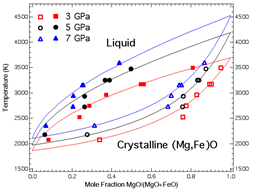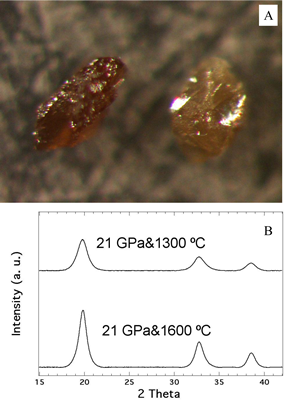1). Deep Mantle Mineralogy
The lower mantle comprises 55 percent of the planet by volume. It stretches from the so-called transition zone between it and the upper mantle at 670 kilometers depth and 24 GPa of pressure and the core-mantle boundary at 2,900 kilometers and 136 GPa of pressure. We do not have direct access to the deep Earth. Instead, we have two ways to examine the mantle: high pressure-temperature experiments that artificially squeezing and heating minerals in a lab to see what they turn into; seismic waves that pass through the Earth, slowing down and speeding up depending on the minerals they intersect.
L. Zhang, Y. Meng, W. Yang, L. Wang, W. L. Mao, Q.-S. Zeng, J. S. Jeong, A. J. Wagner, K. A. Mkhoyan, W. Liu, R. Xu, and H.-k. Mao (2014) Disproportionation of (Mg,Fe)SiO3 perovskite in Earth’s deep lower mantle, Science, 344, 877-882, doi: 10.1126/science.1250274.
2).Single-crystal structures of minerals at Megabar pressure
High pressures produce complicated crystal structures. Polycrystalline structural refinement is inadequate, and single-crystal x-ray diffraction will be the idea method for structure refinement. However, the conventional single-crystal methods require the minimum of 5-10 µm-size single crystals that are unachievable in phase transition studies at ultrahigh pressures. We have overcome this problem by sorting out hundreds of sub-µm crystallites, and determined the structure of each individual single-crystallites. The method has also opened the new area of high-pressure single-crystal crystallography with expected wide impact in studies of physics, chemistry, Earth, and materials sciences.

L. Zhang, Y. Meng, P. Dera, W. Yang, W. L. Mao, and H.-k. Mao (2013) Single-crystal structure determination of (Mg,Fe)SiO3 postperovskite, Proc. Natl. Acad. Sci. USA, doi:10.1073/pnas.1304402110.
Zhang, L., Popov, D., Meng, Y., Wang,J., Ji, C., Li, B., and Mao, H.-k. (2016) In-situ crystal structure determination of seifertite SiO2 at 129 GPa: studying a minor phase near Earth’s core–mantle boundary. American Mineralogist, 101, 231-234. pdf
3).Melting of Earth materials at high pressure
Melting is the most important mechanism by which the terrestrial planets evolve, providing efficient mass and heat transport. Understanding the melting behavior of materials at high pressure remains a hot topic in Earth and planetary sciences and condensed matter physics because of its applications to planetary interiors and contributions to fundamental physics.

L. Zhang and Y. Fei (2008). Melting behavior of (Mg,Fe)O solid solutions at high pressure, Geophys. Res. Lett., 35, L13302, doi:10.1029/2008GL034585.
4). Physics and chemistry at high pressure
5). Synthesis of functional materials at high P-T conditions
Diamond is a material with superlative properties. It is the material with the greatest hardness and the highest thermal conductivity. We may alter its properties and morphology through controlling the P-T conditions for synthesis and choosing different starting materials.

L. Zhang, P. Mohanty, N. Coombs, Y. Fei, H.-K. Mao, and K. Landskron (2010). Catalyst-free synthesis of transparent, mesoporous diamond monoliths from periodic mesoporous carbon CMK-8, Proc. Natl. Acad. Sci. USA, doi:10.1073/pnas.1006938107.
6). Development of high P-T device and probe techniques
